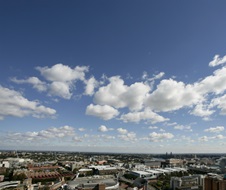The 2019-20 bushfires in NSW brought the stark importance of air quality to the attention of all residents across the state. While Australia has some of the best air quality in the world, the NSW Government is committed to continually improving the state's air quality.

As part of that commitment, the 2023 Annual Air Quality Statement is being released today.
The Annual Air Quality Statement summarises data collected from the NSW Air Quality Monitoring Network each year and is a key component of the 2021–2030 NSW Clean Air Strategy.
The 2023 Statement shows that NSW experienced good air quality in 2023, despite warmer and drier conditions.
The report's key findings show:
- Air quality in 2023 deteriorated marginally compared to 2022. However, 2022 was the state's best air quality on record due mainly to cooler, wetter weather which contributed to fewer bushfires, hazard reduction burns and windblown dust.
- Four of the state's 16 air quality regions met national standards 100% of the time in 2023. These were: Central Coast, Lake Macquarie, Lower Hunter, and Southern Tablelands.
- Air quality standards were met at least 96% of the time in all regions, except for Newcastle Local, which met standards 84% of the time, due to sea salt raising PM10 levels at Stockton.
- Across the 16 regions, there were 47 days in 2023 when at least one national standard was not met. This compares with 19 days in 2022.
- Particle pollution PM10 and PM2.5 continues to be the main source of air pollution mostly due to hazard reduction burns, bushfires, wood heater emissions, and dust. Particle concentrations increased by approximately 30% from 2022.
- Of the gaseous pollutants, sulphur dioxide levels exceeded national standards on 2 days at Muswellbrook station in the Upper Hunter region, and Bradfield Highway roadside monitoring station did not meet the nitrogen dioxide annual standard in 2023. Ozone levels exceeded national standards on 3 days.
- New South Wales experienced a warmer and drier year compared to 2022, but rainfall from late spring moderated the intensifying hot and dry conditions, and likely as a result the air quality.
- Rural areas experienced fewer hours of dust on average, despite expanding drought conditions.
The NSW Government monitors air quality at 99 stations located in 19 regions. Near real time air quality information is available on the Air Quality NSW website, including hourly readings, air quality categories and the relevant health advice and the Sydney forecast.
Actions under the Clean Air Strategy focus on improving air quality and protecting people's health. The main achievements for 2023 included improved bushfire smoke forecasting and support for councils to use low-cost sensors.
Community members can subscribe to receive notifications on poor air quality days in their local area, including during air quality incidents such as bushfires, hazard reduction burns, dust storms and ozone events.
The 2023 Annual Air Quality Statement can be found here: NSW annual air quality statement 2023.
Quotes attributable to Minister for Climate Change and the Environment Penny Sharpe:
"The Annual Air Quality Statement is an important piece of information that guides how we continually try to improve air quality for everyone in New South Wales.
"One of the key actions we are taking is decarbonisation of our electricity system which will not only reduce greenhouse gas emissions but also improve air quality for everyone."






